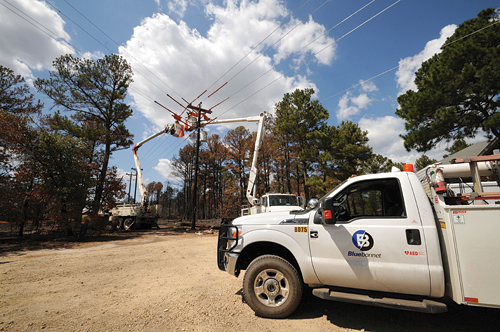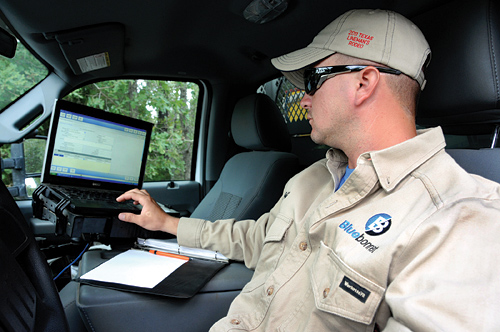In 2011, Texas experienced one of the worst droughts in the state’s history, with very little rainfall and record high temperatures. During the state’s wildfire season, which persists from mid November through late September, firefighters responded to an unprecedented 23,519 fires that burned an estimated 3.8 million acres and more than 2,800 homes. On the Labor Day weekend, the most devastating of these wildfires raged through Bastrop Country in Central Texas, claiming 34,000 acres and destroying 1700+ structures.
Bluebonnet Electric Cooperative, one of the largest electric co-ops in Texas, began its major restoration effort three days after the wildfires. More than 200 miles of Bluebonnet’s electric lines fell inside the burn zone. All told, 4,300 meters lost power, 632 poles and 45 miles of line were replaced, and crews worked 252 miles of right-of-way in the aftermath. Normally, an event of this magnitude would keep crews on the frontlines for months – but Bluebonnet’s crews, bolstered by 450 contractors – had all power restored roughly three weeks later. What made the difference? According to Bluebonnet, teamwork, training and mobile workforce management technology.
In 2009, driven by the CEO’s vision of paperless workflow between field crews and the office, the co-op had kicked off a multi-year, multi-phased enterprise software project to go mobile with 30+ service order types. Since streamlining routine field operations with its mobile workforce management system, the coop has experienced dramatic results, including a 50-60% faster order closure rate and an 80-90% reduction in radio traffic. And in the face of September’s massive wildfires, the solution proved invaluable in helping Bluebonnet to safely, quickly and efficiently get the power flowing again to its members.
A New Beginning
In 2004, a new management team put Bluebonnet on a quest to become the “best co-op in the country.” To guide the process, Bluebonnet chartered a mission and a strategic vision that improved member service. A number of significant projects were identified to support the ambitious transformation the company was seeking, and implementing a mobile workforce management solution was one of them.
As Bluebonnet began to more closely examine field service operations, the existing approach was compared to major congestion on the interstate: lots of problems inhibiting meaningful momentum. Members were geographically dispersed over a large area; crews relied on manual, paper-intensive order procedures; communication between the office and the field was limited to the start and end of the work day; and information was often delayed, not accurate – or worse still – unavailable. The company also wanted to enhance compliance with the Federal Trade Commission’s Red Flags Rule that protects its members’ information from identify theft. The executive mandate was to find opportunities in the problems and to dramatically alter the state of its field operations… and Bluebonnet did.
Now entering the fourth phase of its multi-year implementation cycle, Bluebonnet’s mobile workforce management solution has brought about a fundamental shift to paperless workflow between dispatch and the field, dramatic gains in capacity in terms of the number of orders completed per month and, quite unexpectedly, instrumental outage restoration efforts in the wake of massive wildfires that destroyed more than 1,700 structures in September of 2011.

Going Mobile
Bluebonnet provides electricity to members in 14 counties over more than 3,800 square miles, serves more than 82,000 meters and maintains 11,000 miles of power lines. After implementing a new SAP R/3 system in 2005 and a new GIS in 2007, the company turned its attention to another strategic technology innovation: a mobile workforce management solution. The system closes the gap between the office and the field with dispatching and mobile applications that use real-time wireless communications to manage day-to-day field operations. It eliminates the costs and inefficiencies of voice communication and paper-based data collection in the field and data entry in the office.
Dispatchers and supervisors send order assignments wirelessly to crews, easily monitor the progress of work with real-time status updates and make informed decisions in response to alerts and emergencies. Ronnie Bludau, Operations Technology, Bluebonnet, explains:
“Mark Rose, our CEO, envisioned paperless workflow between dispatch and crews, crews working directly from their trucks, and work completed without any manual interaction or human intervention in the field or the office. Given the scale of this type of change, we formed an interdisciplinary team on the mobile project. It included operations as well as engineering, GIS and IT. After the evaluation process was complete, we selected the mobile workforce management solution from Clevest Solutions and got to work.”
A Phased Approach
The project team identified 31 order types and processes for mobility and real-time communication. In May 2008, Phase 1 of the implementation began with six of these, which represented the most common and critical types of orders. The first interface between the Clevest mobile workforce management solution and the SAP R/3 system also went live at this time. With 80 vehicles equipped with laptops, Bluebonnet’s field team received this first subset of order types wirelessly and sent order completion details in real-time back to the office – and seamlessly to the SAP system.
Bluebonnet subsequently rolled out 14 more order types in Phases 2 and 3 of the project, including an interface between the workforce management solution and the new GIS, as well as the ability for Bluebonnet’s crews to create orders in the field as required.
Bludau elaborated, “On average, we went live with one new order type per month, and the multi-phased approach we took to the project worked well. It helped us to prioritize and focus our efforts, gave us a more controlled environment to learn within, and generally made an enormous undertaking much more manageable.”
In Phase 4 of the project, planned to begin in early 2012, Bluebonnet’s objective is to implement its last 11 order types.
Dramatic Results
For Bluebonnet, the results of going mobile have been compelling across many aspects of the business. The shift to paperless workflow has galvanized significant savings associated with work order closure. With far less administration and manual involvement required, the function is now handled by a team of five instead of seven, and employees formerly part of the group have been redirected toward higher value work. Daily radio traffic and telephone calls have been reduced by a staggering 80 to 90 percent, and the resulting quiet has allowed for improved concentration for dispatchers and supervisors who work more now on managing alerts and emergency conditions when they arise. For crews in the field, it has meant much faster work order closure…
“Field crews no longer have to phone in to an order close out group, and get frustrated by busy signals only to finally get through and learn they’ve not met the necessary validation on a particular order,” explains Bludau. “The system relieves them of this kind of time-consuming administration and lets them focus more on the work at hand.”
By eliminating manual, paper-based processes, Bluebonnet has also achieved standards of data accuracy and protection that previously were unattainable. With reliable and encrypted customer information in every interaction, Bluebonnet is meeting nationwide requirements for an effective Red Flags program to maintain the privacy of customer information and to ensure the information is not at risk.

The ability to append external attachments to an order, whether from the field to dispatch or vice versa, is one particular feature that has proven instrumental in improving the accuracy of information. For example, instead of writing down serial numbers and meter reads for meter swap orders, crews now simply attach a picture of both the old and new meters to the order, which eliminates any errors in serial numbers that reside in the SAP system. Costly errors are caught and corrected early, and any meter tampering or damage is recorded and shared immediately so it can be effectively addressed. Bludau also notes that crews have a bonus plan tied to error-free billing…
“Mobile data has improved billing accuracy so much so that the team routinely exceeds targets and is rewarded accordingly,” he explains.
In addition to the operational benefits associated with going paperless, Bluebonnet has also realized dramatic gains in capacity across its field operations. More than 2,500 work orders are now processed each month using the mobile workforce management solution. Each field tech is completing more work on a daily basis. Crews start the day from home as they no longer need to drive into a dispatch center for orders. They gain productive time throughout the day with real-time wireless communication and required order and asset information at their fingertips. Crews are assigned areas and work efficiently in their area; they no longer end up accidentally working in side-by-side locations. Improved productivity and efficiency in the field has also translated into fuel savings as crews spend more time working and less time driving.
Bludau emphasizes, “The field team has been really positive about the system since its initial installation. It makes their jobs easier; they enter a bit of information and they’re onto the next order.”
Bludau goes on to describe the most telling endorsement in this way: “When it’s taken offline or goes down temporarily, they complain!”
In the Line of Fire
In addition to streamlining routine field operations, the mobile workforce management proved invaluable in September 2011 during a major natural disaster – not only to workers in the field, but also to the public at large in terms of ensuring safety during the restoration efforts. Feeding off one of the worst droughts in the state’s history, combined with high winds and record high temperatures, massive wildfires raged through Bastrop County in Central Texas over the Labor Day weekend. More than 200 miles of Bluebonnet’s electric lines fell inside the burn zone, which ultimately claimed 34,068 acres and destroyed 1,670 homes and 40 commercial buildings.
The business agility of Bluebonnet during the emergency and major restoration effort was unprecedented. With its own headquarters in danger, the co-op was forced to evacuate and move swiftly into a backup control center. Immediately the mobile workforce management solution was available for dispatching orders, with no disruption. The company’s field workers were joined by 450 contractors called in from Asplundh, McCoy Tree Service, Line Tech, Clay Richardson Construction and T&D. Crews began restoring power three days after the fire began, and worked 14- to 16-hour shifts until all power was restored, roughly three weeks later.
Normally, during an event of this size, it would take months to restore all service. All told, 4,338 meters lost power at the peak of the fire; crews replaced 1,000 poles, 56 miles of line, 250 transformers and worked 252 miles of right-of-way – with all activities in the field supported by the mobile solution.
According to Bludau, “It was a huge contributing factor. Without it, everything would have slowed down and delayed communications and the completion of work.”
Bluebonnet initially estimated restoration efforts would take approximately five weeks. What made the difference? For Bluebonnet, the answer is clear: technology, training and teamwork all helped to reduce restoration time by almost two weeks – and all of this while the co-op continued to serve the roughly 90 percent of its members who were not affected by the fire.
Finally, safety is a foundational value for Bluebonnet. The co-op’s Emergency Response Plan, including the functioning of its mobile workforce management system, is constantly evaluated and is adaptable to all emergencies. Once a year, Bluebonnet stages a mock event to test the plan’s effectiveness as well as the emergency response team’s readiness. Thanks to this preparedness and ongoing commitment to safety, in the face of the Labor Day fires, the co-op was able to evacuate its headquarters quickly and without incident.
Looking Forward
The results spurred on by Bluebonnet’s mobile workforce management solution have – at their core – transformed member service, which was the impetus for the company’s multi-year metamorphosis. The field tech is the face of a utility organization and crews are on the frontlines of member service; anything, therefore, that brings about changes to field operations will directly affect the customer’s experience of the company.
For Bluebonnet, its mobile workforce management solution does just that. The co-op continues to pass on the benefits of the system to its members, and anticipates additional savings and efficiency gains this year as the project enters its final phase. The company is also evaluating the potential for implementing Clevest’s outage management capabilities as part of its ongoing commitment to industry-leading rapid response and emergency preparedness – which has already been put to the test!
About the Author
 Ronnie Bludau is Operations Technology Superintendent for Bluebonnet Electric Cooperative. He is responsible for telecommunications, AMR and GIS departments at Bluebonnet Electric, as well as project management for mobile data and new metering technologies.
Ronnie Bludau is Operations Technology Superintendent for Bluebonnet Electric Cooperative. He is responsible for telecommunications, AMR and GIS departments at Bluebonnet Electric, as well as project management for mobile data and new metering technologies.







